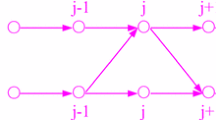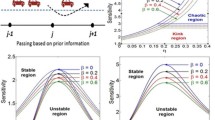Abstract
In real traffic, driver’s behavior influences lane changing and hence traffic dynamics. Motivated by the impact of driver’s behavior on lane changing phenomenon, we introduce a lattice model by considering driver’s behavior with empirical lane changing rate. To analyze the two lane traffic system more effectively, the lane changing rate is assumed to be dependent on density and their relationship is considered based on available empirical data. Theoretical analysis is performed to study the effect of small amplitude perturbation as well as long wavelength perturbation on traffic characteristics. Stability condition is obtained via linear stability analysis and the modified Korteweg–de Vries equation is formulated through nonlinear analysis to describe the propagating behavior of traffic density wave near the critical point. It is found that empirical lane changing has a nontrivial influence on traffic dynamics in terms of stabilizing/destabilizing traffic flow. All the theoretical results are verified with numerical simulations on a hypothetical circular road.
Graphic Abstract











Similar content being viewed by others
Data Availability Statement
This manuscript has no associated data or the data will not be deposited. [Authors’ comment:...].
References
D. Chowdhury, L. Santen, A. Schadschneider, Statistical physics of vehicular traffic and some related systems. Phys. Rep. 329(4–6), 199–329 (2000)
K. Nagel, M. Schreckenberg, A cellular automaton model for freeway traffic. J. Phys. I 2(12), 2221–2229 (1992)
T. Nagatani, The physics of traffic jams. Rep. Prog. Phys. 65(9), 1331 (2002)
P. Berg, A. Mason, A. Woods, Continuum approach to car-following models. Phys. Rev. E 61(2), 1056 (2000)
R. Jiang, Q.S. Wu, Z.J. Zhu, A new continuum model for traffic flow and numerical tests. Transp. Res. Part B 36(5), 405–419 (2002)
M. Bando, K. Hasebe, A. Nakayama, A. Shibata, Y. Sugiyama, Structure stability of congestion in traffic dynamics. Jpn. J. Ind. Appl. Math. 11(2), 203–223 (1994)
M. Bando, K. Hasebe, A. Nakayama, A. Shibata, Y. Sugiyama, Dynamical model of traffic congestion and numerical simulation. Phys. Rev. E 51(2), 1035 (1995)
H.Y. Lee, H.W. Lee, D. Kim, Origin of synchronized traffic flow on highways and its dynamic phase transitions. Phys. Rev. Lett. 81(5), 1130 (1998)
D. Huang, Lane-changing behavior on highways. Phys. Rev. E 66(2), 026124 (2002)
L. Yang, X. Li, W. Guan, H.M. Zhang, L. Fan, Effect of traffic density on driver’s lane change and overtaking maneuvers in freeway situation—a driving simulator-based study. Traffic Inj. Prev. 19(6), 594–600 (2018)
T. Wang, T.Q. Tang, L. Chen, H.J. Huang, Analysis of trip cost allowing late arrival in a traffic corridor with one entry and one exit under car-following model. Physica A 521, 387–398 (2019)
T. Nagatani, Modified KdV equation for jamming transition in the continuum models of traffic. Physica A 261(3), 599–607 (1998)
T. Nagatani, TDGL and MKdV equations for jamming transition in the lattice models of traffic. Physica A 264(3–4), 581–592 (1999)
H. Ge, R. Cheng, The backward looking effect in the lattice hydrodynamic model. Physica A 387(28), 6952–6958 (2008)
G.H. Peng, X.H. Cai, B.F. Cao, C.Q. Liu, Non-lane-based lattice hydrodynamic model of traffic flow considering the lateral effects of the lane width. Phys. Lett. A 375(30), 2823–2827 (2011)
G.H. Peng, X.H. Cai, C.Q. Liu, B.F. Cao, A new lattice model of traffic flow with the consideration of the honk effect. Int. J. Mod. Phys. C 22(9), 967–976 (2011)
T. Jun-Fang, J. Bin, L. Xing-Gang, G. Zi-You, Flow difference effect in the lattice hydrodynamic model. Chin. Phys. B 19(4), 040303 (2010)
J.F. Tian, Z.Z. Yuan, B. Jia, M.H. Li, G.H. Jiang, The stabilization effect of the density difference in the modified lattice hydrodynamic model of traffic flow. Physica A 391, 4476–4482 (2012)
T. Nagatani, Stabilization and enhancement of traffic flow by the next-nearest-neighbor interaction. Phys. Rev. E 60, 6395–6401 (1999)
T.Q. Tang, X.F. Luo, K. Liu, Impacts of the driver’s bounded rationality on the traffic running cost under the car-following model. Physica A 457, 316–321 (2016)
A.K. Gupta, P. Redhu, Analyses of the driver’s anticipation effect in a new lattice hydrodynamic traffic flow model with passing. Nonlinear Dyn. 76(2), 1001–1011 (2014)
D.H. Sun, C. Tian, A traffic flow lattice model with the consideration of driver anticipation effect and its numerical simulation. Acta Physica Sinica 60(6), 068901 (2011)
X.Q. Li, K.L. Fang, G.H. Peng, A new lattice model of traffic flow with the consideration of the driver’s aggressive characteristics. Physica A 468, 315–321 (2017)
S. Sharma, Modeling and analyses of driver’s characteristics in a traffic system with passing. Nonlinear Dyn. 86(3), 2093–2104 (2016)
R. Kaur, S. Sharma, Analysis of driver’s characteristics on a curved road in a lattice model. Physica A 471, 59–67 (2017)
N. Madaan, S. Sharma, Effects of multi-phase optimal velocity function on a lattice model accounting for driver’s behavior. Int. J. Mod. Phys. B 33(22), 1950248 (2019)
D. Kaur, S. Sharma, The impact of the predictive effect on traffic dynamics in a lattice model with passing. Eur. Phys. J. B 93(3), 1–10 (2020)
G. Zhang, D. Sun, W. Liu, M. Zhao, S. Cheng, Analysis of two-lane lattice hydrodynamic model with consideration of driver’s characteristics. Physica A 422, 16–24 (2015)
S. Sharma, Lattice hydrodynamic modeling of two-lane traffic flow with timid and aggressive driving behavior. Physica A 421, 401–411 (2015)
T. Nagatani, Jamming transitions and the modified Korteweg’de Vries equation in a two-lane traffic flow. Physica A 265, 297–310 (1999)
A.K. Gupta, P. Redhu, Analyses of driver’s anticipation effect in sensing relative flux in a new lattice model for two-lane traffic system. Physica A 392(22), 5622–5632 (2013)
T. Wang, Z. Gao, J. Zhang, X. Zhao, A new lattice hydrodynamic model for two-lane traffic with the consideration of density difference effect. Nonlinear Dyn. 75, 27–34 (2014)
G.H. Peng, H. Kuang, H. Zhao, L. Qing, Nonlinear analysis of a new lattice hydrodynamic model with the consideration of honk effect on flux for two-lane highway. Physica A 515, 93–101 (2019)
W. Tao, G. Zi-You, Z. Xiao-Mei, T. Jun-Fang, Flow difference effect in the two-lane lattice hydrodynamic model. Chin. Phys. B 21(7), 070507 (2012)
S. Sharma, Effect of driver’s anticipation in a new two-lane lattice model with the consideration of optimal current difference. Nonlinear Dyn. 81(1–2), 991–1003 (2015)
G.H. Peng, A new lattice model of two-lane traffic flow with the consideration of optimal current difference. Commun. Nonlinear Sci. Numer. Simul. 18(3), 559–566 (2013)
D. Kaur, S. Sharma, A new two-lane lattice model by considering predictive effect in traffic flow. Physica A 539, 122913 (2020)
F. Sun, A.H.F. Chow, S.M. Lo, H. Ge, A two-lane lattice hydrodynamic model with heterogeneous lane changing rates. Physica A 511, 389–400 (2018)
A.K. Gupta, P. Redhu, Analysis of a modified two-lane lattice model by considering the density difference effect. Commun. Nonlinear Sci. Numer. Simul. 19(5), 1600–1610 (2014)
X. Qi, R. Cheng, H. Ge, Analysis of a novel two-lane lattice model with consideration of density integral and relative flow information. Eng. Comput. 37, 2939–2955 (2020)
X. Qi, H. Ge, R. Cheng, Analysis of a novel two-lane hydrodynamic lattice model accounting for Driver’s aggressive effect and flow difference integral. Math. Probl. Eng. (2020). https://doi.org/10.1155/2020/8258507
J. Zhang, K. Xu, S. Li, T. Wang, A new two-lane lattice hydrodynamic model with the introduction of driver’s predictive effect. Physica A 551, 124249 (2020)
N. Madaan, S. Sharma, A lattice model accounting for multi-lane traffic system. Physica A 564, 125446 (2021)
C. Zhu, S. Zhong, S. Ma, Two-lane lattice hydrodynamic model considering the empirical lane-changing rate. Commun. Nonlinear Sci. Numer. Simul. 73, 229 (2019)
T. Wang, R. Cheng, H. Ge, Analysis of a novel two-lane lattice hydrodynamic model considering the empirical lane changing rate and the self-stabilization effect. IEEE Access 7, 174725–174733 (2019)
Q. Wang, R. Cheng, H. Ge, A new two-lane lattice hydrodynamic model on a curved road accounting for the empirical lane-changing rate. Eng. Comput. (2020). https://doi.org/10.1108/EC-04-2020-0230
D. Kaur, S. Sharma, Prior information affecting traffic dynamics in a two dimensional (2D) network. Eur. Phys. J. B 94(9), 1–12 (2021)
Acknowledgements
SERB-POWER supports this work under grant SPG/2021/000591 and by DST-FIST (Govt. of India) for the grant SR/FIST/MS-1/2017/13.
Author information
Authors and Affiliations
Contributions
SS proposed the idea, supervised the work and interpret the results. The implementation of idea, analysis, and the simulation have been performed by NM. NM and SS prepared the manuscript.
Corresponding author
Ethics declarations
Conflict of interest
The authors declare that they have no conflict of interest.
Rights and permissions
About this article
Cite this article
Madaan, N., Sharma, S. Influence of driver’s behavior with empirical lane changing on the traffic dynamics. Eur. Phys. J. B 95, 6 (2022). https://doi.org/10.1140/epjb/s10051-021-00270-0
Received:
Accepted:
Published:
DOI: https://doi.org/10.1140/epjb/s10051-021-00270-0




